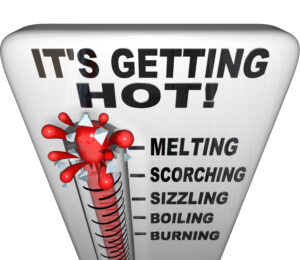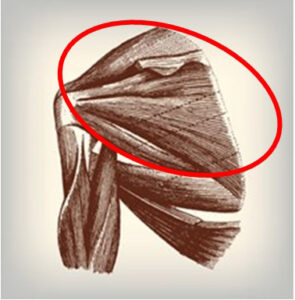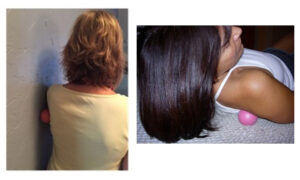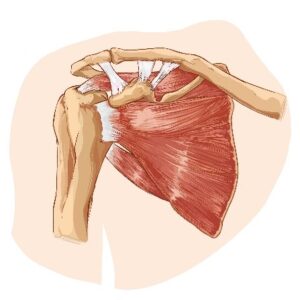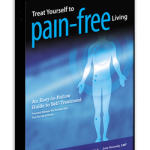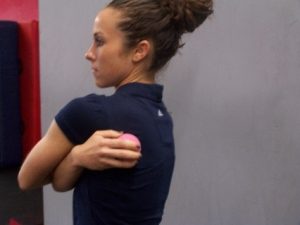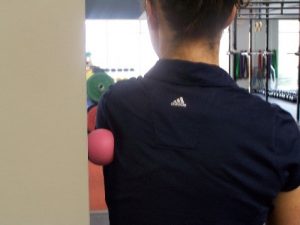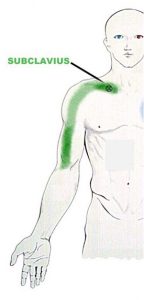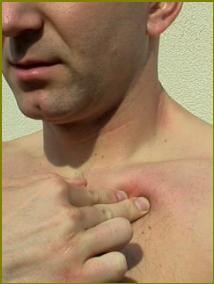Treating Your Levator Scapulae Muscle
Author: Julie Donnelly, LMT – The Pain Relief Expert
Editor: Dr. Steve Chaney
 This newsletter is moving into the 21st century! Everyone has been pushing me to get into videos, but I’m often a dinosaur and I could relate to just text and photos, so I pushed back. And finally, I saw the benefit to everyone of using videos.
This newsletter is moving into the 21st century! Everyone has been pushing me to get into videos, but I’m often a dinosaur and I could relate to just text and photos, so I pushed back. And finally, I saw the benefit to everyone of using videos.
Last month I included just the self-treatment video, and this month I’m moving even further ahead. I’ve filmed at least 40 videos explaining all kinds of info about muscles and pain. Each month the newsletter will have one of those explanatory videos, and 1-2 self-treatment videos that relate to the topic being discussed.
I’d really appreciate your feedback on this new way of presenting my info about why muscles cause pain and what you can do about it. I also appreciate your patience while I learn this new method as I’m sure I’ll be making some technical mistakes. 😊
 A BIG shout-out to three people who are making this possible:
A BIG shout-out to three people who are making this possible:
Pat White, Carla Sellers,
and Sherri Proctor
I’m also a dinosaur when it comes to creating the videos that are necessary to make all of this happen in the first place. So, I called an expert! I spent many hours with my good friend, Sherri, creating videos of just about everything. Sherri is a fantastic photographer and videographer. Aside from doing all the videos I’ll be sharing with you, Sherri is responsible for almost all the videos I use when I teach massage therapists, and now the self-treatment videos that are being shared with everyone. (If you need a GREAT photographer or videographer, call Sherri at 941-345-5135)
Pat is my webmaster. I can’t begin to list all the work he is doing with the newsletter to make these videos presentable so you can have the best experience watching them. He is also in charge of all my websites, teaching programs for massage therapists, and so much more. Pat also has great patience (or he hides frustration well!) as I move kicking & screaming into this new electronic world!
Thanks to Pat there will be many articles added to the website, each explaining another piece of the puzzle that makes up our body and how it works. The articles have all been tucked away in my computer as I didn’t know what to do with them. It’s fun working on the project of sharing them with everyone.
Plus, Pat is working on a major project that I’ll share with you when it’s ready to come out. I’m so excited!
Carla runs all the social media sites: Facebook, LinkedIn, YouTube, and Instagram. It all started with her just putting SEO and descriptions, and new thumbnail pictures, on each of the videos. She told me that as she watched the videos, she knew she had to do something to help me. That grew from a smallish project to a HUGE project! I’m incredibly grateful for all she has done, and is still doing, to bring my work to the world!
On To The June Newsletter
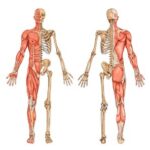 The body is a symphony of muscles, each playing its own part in our ability to move, and each a key player with a group of other muscles in just about everything we do.
The body is a symphony of muscles, each playing its own part in our ability to move, and each a key player with a group of other muscles in just about everything we do.
I can’t possibly give you every treatment that needs to be done to get relief, but I will always give you information on the key muscles that need to be treated.
Relief From Headaches And Shoulder Pain
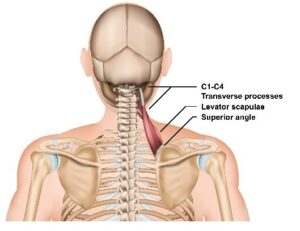 This month I want to share a video that explains a muscle that causes shoulder pain and headaches. The name of the muscle is Levator Scapulae.
This month I want to share a video that explains a muscle that causes shoulder pain and headaches. The name of the muscle is Levator Scapulae.
The levator scapulae muscle originates on the first four cervical vertebrae and inserts into the medial border of your shoulder blade (scapula).
When the muscle contracts normally it lifts your shoulder blade, hence the nickname, “the shrug muscle.”
Click Here to watch the video explaining this muscle and why it causes headaches and shoulder pain
JulstroMethod Self-Treatment For The Levator Scapular Muscle
You’ll need a ball to do this self-treatment. If you’ve been in to see me, you have the Perfect Ball, which really is perfect to do this treatment correctly.
Click Here to watch how to quickly and easily release the tension in your shoulder muscle.
Snowbirds And Clients Around The World –
Zoom Consultations Are Available
 I’ve successfully worked with people around the world for many years.
I’ve successfully worked with people around the world for many years.
I also love working with Snowbirds who are in Sarasota all winter, and then head north when it gets hot here. It’s so nice to see you, and to help you stop aches and pains.
The way we work together is simple:
- You go to https://julstromethod.com/product/one-on-one-zoom-consultation/ and order a private consultation.
- You send me an email explaining what is wrong, where you feel the pain, what you’ve done to treat it so far, etc., etc. Don’t tell me about medications because that is far out of my scope of practice so I can’t give any advice about them.
- We meet on Zoom and work together to find and eliminate the source of your pain.
- You receive the Zoom recording so you can watch it again later to refresh your memory about the treatments.
All this for only $147.
Have a beautiful summer!
Wishing you well,
Julie Donnelly
www.FlexibleAthlete.com
These statements have not been evaluated by the Food and Drug Administration. This information is not intended to diagnose, treat, cure, or prevent any disease.
About The Author
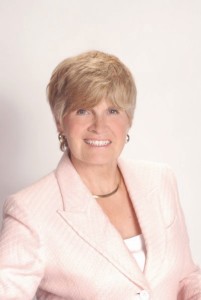 Julie Donnelly has been a licensed massage therapist since 1989, specializing in the treatment of chronic pain and sports injuries. The author of several books including Treat Yourself to Pain-Free Living, The Pain-Free Athlete, and The 15 Minute Back Pain Solution.
Julie Donnelly has been a licensed massage therapist since 1989, specializing in the treatment of chronic pain and sports injuries. The author of several books including Treat Yourself to Pain-Free Living, The Pain-Free Athlete, and The 15 Minute Back Pain Solution.
Julie has also developed a proven self-treatment program for the symptoms of carpal tunnel syndrome.
She has a therapy practice in Sarasota, Florida, and she travels around the USA to teach massage and physical therapists how to do the Julstro Method, and she also teaches self-treatment clinics to anyone interested in taking charge of their own health and flexibility.
She may be reached at her office: 919-886-1861, or through her website: www.FlexibleAthlete.com
About The Editor
 Dr. Chaney has a BS in Chemistry from Duke University and a PhD in Biochemistry from UCLA. He is Professor Emeritus from the University of North Carolina where he taught biochemistry and nutrition to medical and dental students for 40 years.
Dr. Chaney has a BS in Chemistry from Duke University and a PhD in Biochemistry from UCLA. He is Professor Emeritus from the University of North Carolina where he taught biochemistry and nutrition to medical and dental students for 40 years.
Dr. Chaney won numerous teaching awards at UNC, including the Academy of Educators “Excellence in Teaching Lifetime Achievement Award”. Dr Chaney also ran an active cancer research program at UNC and published over 100 scientific articles and reviews in peer-reviewed scientific journals. In addition, he authored two chapters on nutrition in one of the leading biochemistry text books for medical students.
Since retiring from the University of North Carolina, he has been writing a weekly health blog called “Health Tips From the Professor”. He has also written two best-selling books, “Slaying the Food Myths” and “Slaying the Supplement Myths”. And most recently he has created an online lifestyle change course, “Create Your Personal Health Zone”. For more information visit https://chaneyhealth.com.
For the past 45 years Dr. Chaney and his wife Suzanne have been helping people improve their health holistically through a combination of good diet, exercise, weight control and appropriate supplementation.

